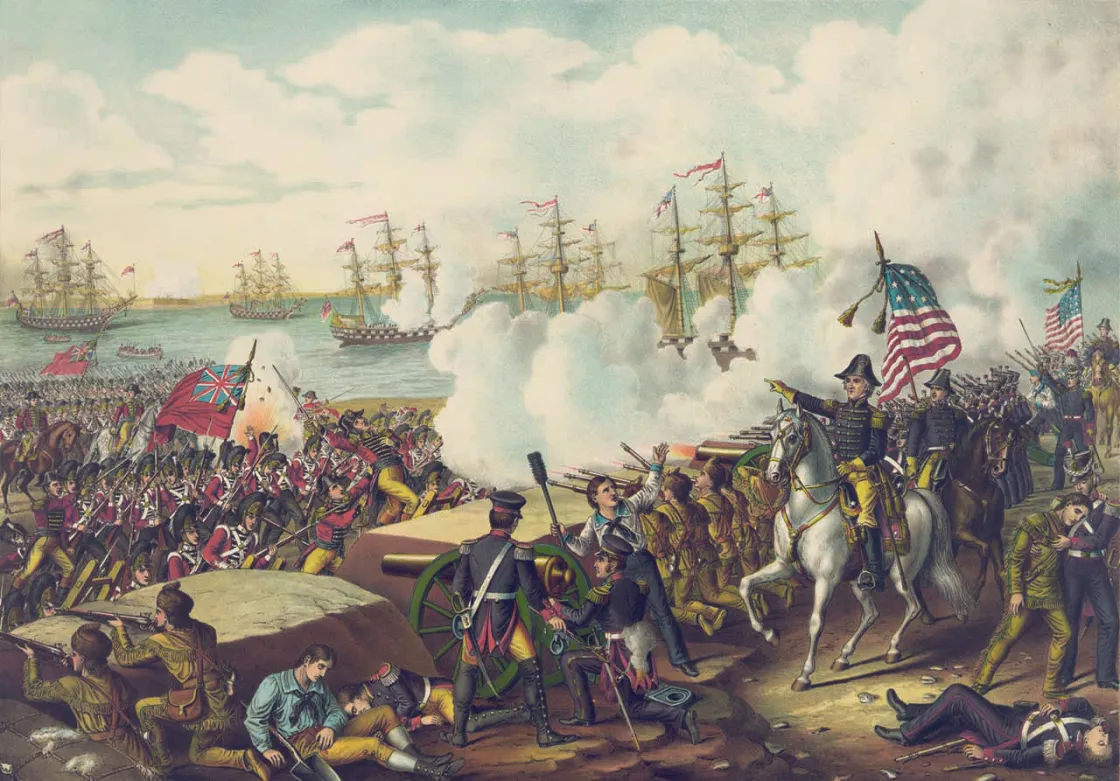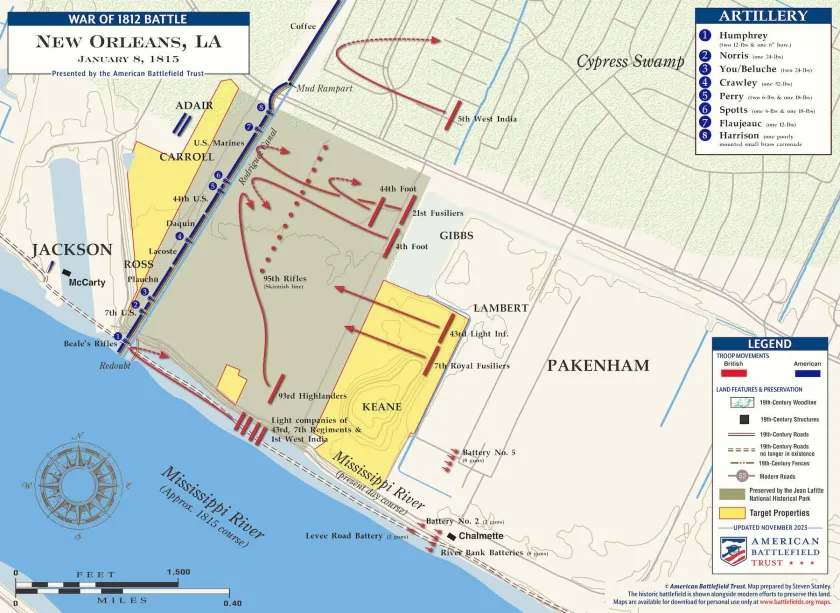The Battle of Moot

Chalmette Battlefield, La.
The Treaty of Ghent was signed in Belgium on December 24, 1814, officially ending the War of 1812 between the United States and Great Britain. But it took months for news of the diplomats’ peaceful resolution to the conflict and the treaty’s ratification to cross the Atlantic; word did not reach the American and British militaries until May 1815. And in the interim, the British Royal Navy executed an assault on the port city of New Orleans.
Originally, the vision was to take Mobile, Ala., but Vice Admiral Alexander Cochrane convinced the admiralty that an attack on New Orleans would more effectively weaken the United States. Cutting off the mouth of the Mississippi and seizing the Crescent City some 95 miles north of the Gulf of Mexico would cause the American South and West to lose access to trade and necessary resources for survival. To ensure success, the British developed plans to simultaneously attack by sea and land. Cochrane dispatched Major Edward Nicolls’s of the Royal Marines to recruit and train local Native American tribes from west Florida to the Mississippi Delta to fight on the King’s behalf with the promise that their lands would be returned to them. In addition, the Royal Navy would blockade the port and transport 8,000 infantry troops to Louisiana.

Around September 5, American Acting Secretary of War James Monroe warned Major General Andrew Jackson, based in Mobile, of suspected British designs on New Orleans. A contingent of Royal Marines attacked Fort Boyer, across Mobile Bay, unsuccessfully on September 14, while the main body remained ensconced at Pensacola. Jackson, responding to American misfortunes to the north, including the burning of Washington, took the fight to West Florida in early November, taking the city with fewer than a dozen casualties.
Leaving a small garrison behind, Jackson took the bulk of his force to Louisiana. While the Americans were en route, the Royal Navy approached the mouth of the Mississippi River. Cochrane ordered the HMS Armie and Sophie to sail near Bayou Bienville and look out for American ships. As the ships patrolled the area, they established rendezvous points for the future attack on New Orleans. When the vessels entered Lake Borgne, they met a squadron of five American gunboats, a dispatch boat and a tender — a ship providing supplies, communication and transportation to the other ships — led by Thomas Catesby Jones. Most of the American gunboats were each equipped with five guns and a crew of around 35 to 40 men.
Jones and his men had been warned of Cochrane’s plan of attack, so when they first spotted the British fleet, he had some of his men scope it out. Recognizing the sheer number of men and ships, Jones moved his fleet to a shallow area of the lake for a more tactical position. Cochrane needed to defeat the flotilla of American gunboats to get his ground troops into New Orleans successfully. After evaluating the lake, it was determined that it was too shallow to send a ship of the line to pursue the American flotilla. Instead, Cochrane placed the commander of the Sophie, Nicholas Lockyer, in command of a fleet of British rowboats. Under Lockyer, 42 open boats and barges were equipped with carronades and 1,200 sailors and Royal Marines now heading toward Jones.
On December 12, Lockyer’s men rowed through the night toward Lake Borgne, and it was not until late the following day that Jones’s fleet was in range. Once the enemy was in sight, Lockyer divided the men and assigned them different targets, including the American sloop Seahorse. Lockyer sent three barges to the Bay of Saint Louis to capture or sink the Seahorse. Spotting the approaching British barges, the American sailors fired, using three six-pounders. After 40 minutes of fighting, the British retreated. Knowing they were at a disadvantage, the Seahorse’s captain blew up his ship to prevent the British from seizing it.
Due to harsh weather, Lockyer’s boats and Jones’s fleet were forced to stop their cat and mouse game for the evening. But the wind had settled by the following morning, and the British continued their advance toward Jones. His compromised position within the Rigolets of Louisiana meant the crew began preparing for the oncoming engagement. After 36 hours of rowing, at 10:00 a.m., 42 of Lockyer’s heavily armed barges met Jones’s squadron of five gunboats. Once in range, two gunboats unsuccessfully fired down upon the enemy. Lockyer’s barges were fast and small, making them a hard target for larger ships and giving the British the advantage. As the battle progressed, two barges were sunk due to failed attempts to seize Jones’s ships. During the heat of the fight, a musket ball hit Jones’s shoulder, forcing him to retire below deck. Command of the American fleet fell into the hands of Lieutenant George Parker. By midday, Lockyer’s men had successfully boarded and seized one of the gunboats and fired on the rest of Jones’s fleet. Confused, the American fleet continued to fight, aiming at both the captured gunboat and the advancing barges. The British quickly overwhelmed the Americans, and the Americans surrendered at 12:40 p.m. on December 14.
The British lost 17 men, with 77 wounded. The American fleet suffered six deaths and 35 wounded. As Lockyer’s men raided and seized the gunboats, the American sailors were questioned about the size of Jackson’s incoming army. With a rough estimate of a couple thousand men heading toward New Orleans, Cochrane’s fleet set sail toward the mouth of the Mississippi. With the removal of the American fleet, Admiral Cochrane sailed toward Pea Island with General Edward Pakenham and his men to lay siege to New Orleans. The British military established Pea Island as a meeting point for additional incoming troops. As the British continued to build their forces, Jackson received word of Jones’s loss at the Battle of Lake Borgne. Without Jones’s gunboats, surveillance of Cochrane and the British fleet was lost, leaving Jackson without vital information. Desperately, Jackson requested assistance from Master Commandant Daniel Patterson and militiamen from Kentucky to prevent the loss of New Orleans to the British.
Jackson and Patterson began collecting supplies to face the British on land and sea. After the Jones’s loss, the American navy around New Orleans consisted of three ships, the USS Louisiana, the USS Carolina and a gunboat. Fortunately, Cochrane decided against sailing up the Mississippi River due to its extreme difficulty. By doing so, Cochrane yielded naval superiority to Patterson’s small flotilla. As the number of British troops grew at Pea Island, Patterson and Master Commandant John Henley sailed the Carolina down the Mississippi and fired upon a British unit. Surprised British troops ran for cover from the cannon fire, which was used to signal Jackson’s troops to attack. Jackson and his men boldly met the enemy in a nighttime attack. Fighting ensued for several hours until Jackson and his men retreated into the night near Rodriguez Canal alongside the river. The Americans established a marine battery in preparation for retaliation by the British.
As Jackson’s men prepared for the incoming assault from General Edward Pakenham’s troops, the Louisiana and the Carolina continued to patrol the waterways in search of British encampments. On December 27, the Carolina sailed down the river, approaching a heavily armed British unit near Villere Plantation. Once spotted, the unit began firing using heated artillery, also known as hot shots, at the Carolina. Henley and his men were forced to abandon the ship, and moments later, Carolina exploded, killing one sailor and wounding six more. The sinking of the Carolina prompted Pakenham to begin marching his men toward New Orleans and the Louisiana to retire upriver out of artillery range. This left Jackson with no naval defense, although Commodore Patterson removed several cannons from the ship and placed them along the west bank of the river to protect the infantry.

On the morning of January 8, General Pakenham’s 8,000 men faced Andrew Jackson’s 5,700 at Chalmette Plantation for the Battle of New Orleans. The battle proved a swift victory for the United States. Jackson and his men utilized earthworks and volleys to damage the British line. The Americans suffered 13 casualties, a minimal figure compared to the British loss of 291, which included General Edward Pakenham. The victory on January 8 aided Jackson’s popularity and his presidential campaign in 1828. Yet the British did not leave Louisiana after the defeat at Chalmette Plantation; instead, the navy remained for a week and made it a goal to destroy Fort St. Phillip. Fortunately for the United States, Jackson had strengthened the fort years prior by adding additional mortars and howitzers to its battery. After the battle, the crew of the remaining American gunboat and 400 regulars occupied the fort, anticipating a British attack. Cochrane and his fleet began firing on Fort St. Phillip to damage and distract Jackson, while safely retreating the British soldiers back to the ship to flee. Cochrane’s bombardment caused enough damage to be taken as a viable threat but on January 18, the British officially left the mouth of the Mississippi and returned to Great Britain.
On February 14, 1815, news of the official ending of the war reached New Orleans. Although the battle occurred after the signing of the Treaty of Ghent, it played a significant role in the United States’s victory during the War of 1812. The United States grew in popularity and dominated the high seas after back-to-back victories against the British Royal Navy. After the war, Daniel Patterson worked to restore the naval station in New Orleans. Promoted to captain, Patterson requested additional ships sent to the station for further protection of the port. Favoring swift shallow-draft vessels, the lightweight ships would prove beneficial due to the large number of lakes, streams and swamps located around the coastal city. As a gesture of gratitude for Patterson’s service and prevention of the British invasion, Congress sent 24 ships to join the station. Despite the war ending, Patterson continued to serve in combat due to the upsurge in piracy and illegal trading within the port. New Orleans would continue to operate as a successful naval station until its closure in 1827, defending the United States from criminal activity and foreign enemies.
Related Battles
71
2,034







